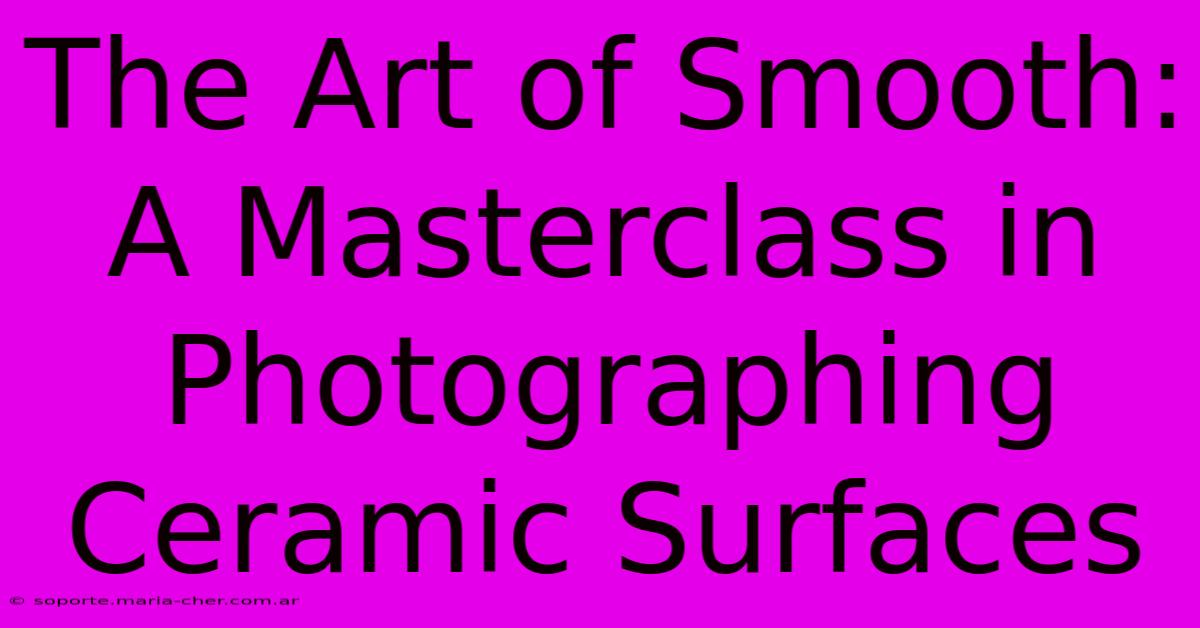The Art Of Smooth: A Masterclass In Photographing Ceramic Surfaces

Table of Contents
The Art of Smooth: A Masterclass in Photographing Ceramic Surfaces
Ceramic surfaces – whether the glossy sheen of a modern vase or the rustic charm of a hand-thrown bowl – present unique photographic challenges. Their smooth, often reflective nature can lead to unwanted glare and distractions, obscuring the very details you want to showcase. Mastering the art of photographing ceramics requires a keen eye for light, a strategic approach to composition, and a thorough understanding of your equipment. This masterclass will guide you through the techniques to achieve stunning, smooth, and captivating images of your ceramic subjects.
Understanding the Challenges: Reflections and Glare
The biggest hurdle in ceramic photography is managing reflections and glare. Ceramic surfaces, especially glazed ones, act like mirrors, reflecting light sources and surrounding environments. This can lead to distracting highlights, washed-out colors, and a lack of detail in the subject itself. Before you even pick up your camera, consider these factors:
- Light Sources: Identify and control your light sources. Harsh, direct sunlight will create harsh reflections. Soft, diffused light is your friend.
- Surroundings: A cluttered background will be reflected onto the ceramic surface, distracting from the main subject. Choose a clean, neutral backdrop.
- Camera Angle: Experiment with different angles to minimize reflections. Shooting slightly off-axis can often help reduce glare.
Mastering the Light: Techniques for Smooth Results
The key to successful ceramic photography lies in skillful lighting. Here are some techniques to help you achieve a smooth, even finish:
1. Diffused Natural Light:
- Embrace Soft Light: Overcast days or soft, filtered sunlight are ideal. The gentle light will minimize harsh reflections. Shoot near a window, but avoid direct sunlight.
- Diffusers: Use diffusers like sheer curtains or white sheets to further soften the light.
2. Artificial Light:
- Softboxes and Umbrellas: These light modifiers diffuse the light from strobes or continuous lighting, creating a softer, more even illumination.
- Reflectors: Position a reflector opposite your main light source to fill in shadows and reduce contrast.
3. Backlighting:
- Subtle Highlights: Careful backlighting can create subtle highlights that accentuate the curves and texture of the ceramic piece, without causing overwhelming glare.
Composition and Backgrounds: Setting the Stage
Even with perfect lighting, a poorly composed image will fall flat. Consider these aspects:
Choosing the Right Background:
- Neutral Backdrops: Opt for simple, neutral backgrounds like white, gray, or a subtly textured fabric that won't compete with the ceramic piece.
- Minimalist Approach: Keep the background clean and uncluttered to draw attention to the subject.
Compositional Techniques:
- Rule of Thirds: Place the ceramic piece off-center to create a more visually appealing image.
- Leading Lines: Use lines in the background to guide the viewer's eye towards the subject.
- Negative Space: Embrace negative space to allow the ceramic piece to breathe and stand out.
Equipment and Settings: Fine-Tuning Your Approach
The right equipment and settings will significantly impact your results:
- Macro Lens: A macro lens allows you to capture intricate details and textures.
- Tripod: A tripod is essential for sharp images, especially when using slower shutter speeds with soft lighting.
- Polarizing Filter: A polarizing filter can help reduce reflections, but use it carefully as it can also reduce the vibrancy of colors.
- Aperture Priority Mode (Av or A): This mode allows you to control the depth of field, blurring the background and focusing attention on the ceramic piece. A narrower aperture (higher f-number, like f/8 or f/11) will provide greater depth of field.
Post-Processing: Polishing the Final Image
Even with meticulous planning and execution, some post-processing may be necessary:
- Light Adjustments: Carefully adjust brightness, contrast, and exposure to fine-tune the image.
- Spot Healing: Remove any dust or blemishes using the spot healing tool.
- Color Correction: Enhance the colors to make them more vibrant and true to life.
By understanding the challenges, mastering the lighting techniques, carefully choosing your composition, and utilizing the appropriate equipment and settings, you can elevate your ceramic photography to a new level. Remember, practice makes perfect. Experiment with different approaches, and soon you’ll be capturing stunning images that truly showcase the beauty and artistry of ceramic surfaces.

Thank you for visiting our website wich cover about The Art Of Smooth: A Masterclass In Photographing Ceramic Surfaces. We hope the information provided has been useful to you. Feel free to contact us if you have any questions or need further assistance. See you next time and dont miss to bookmark.
Featured Posts
-
Warning Dont Let These Ad Fallacies Sway Your Purchase Decisions
Feb 07, 2025
-
Elevate Your Style With The Touch Of Gold The Essential Guide To Gold Vermeil Necklaces
Feb 07, 2025
-
Unleash Your Inner Artist Design Your Own Saddle Stitched Wall Calendar
Feb 07, 2025
-
Unveiling The Hidden Wonders Of The Human Body An Otolaryngologists Journey
Feb 07, 2025
-
Confused About Sewed Or Sowed We Ve Got You Covered
Feb 07, 2025
